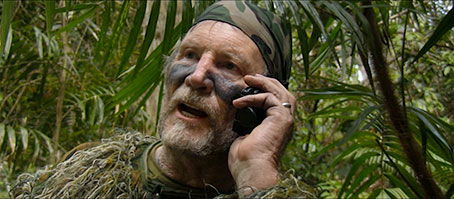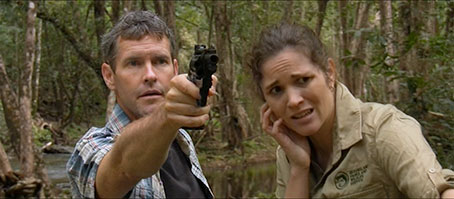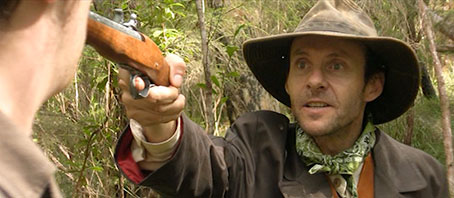|
It all starts back in 18-something-or-other in a jungle area in Australia's North Queensland district, when a Chinese prospector finds a gold nugget and promptly has it stolen by a pistol-wielding local goon. A short while later, the goon in question finds out just what it's like to have your newly acquired spoils taken from you at gunpoint when he's held up by notorious outlaw 'Thunderclap' Newman. But on hearing the prospector meet a grizzly end at the hands of something large that stomps and growls, the goon has other worries. The two men figure it might be prudent to put aside their differences and point their guns at the approaching beast instead. Ignoring Newman's advice, the goon fires his pistol far too early to be of any use. Newman waits until the creature gets near and shoots the goon in the leg. This, he figures, should keep the monster busy while he gets away, but forgets how long it takes to reload one of those old ball and cap pistols. Despite a distinctly digital aesthetic that tends to made period footage look like guys in costumes pretending to be in the past (which it is, of course), it's a rather witty start to a film that I wish I had warmed to more than I actually did.
The story proper begins as two modern-day fortune hunters named Jack and Kent make their way down a river through the very same Australian woodland in which the prologue unfolded. They've come here, we learn, in search of Thunderclap Newman's legendary lost gold. Surprisingly, they find it. Kent is so happy that he throws his mate in the river and holds him under the water until he drowns. Jesus, how did these two hook up? Did Jack take an ad out in Treasure Hunter Monthly and just hope for the best? It's at this point that Kent spies something large in the opposite woodland and wanders over to investigate. Jack, who by now has been unconscious underwater long enough to have involuntarily filled his lungs with fluid, wakes up and hops it. I actually assumed he was faking his unconsciousness and holding his breath until the moment came when he could kick Kent in the nuts, but apparently this wasn't the case. We know this because this whole scene unfolds as a flashback being told by Jack to attractive Park Ranger Rhiannon, the inevitable gutsy princess to Jack's hesitant hero. What follows are a number of variations on the same theme, as the pistol-waving Kent repeatedly catches up to Jack, then the creature does something noisy and Jack and Rhiannon are able to make their escape.

So what is this creature? Well apparently it's a Yowie, a mythical creature born of Aboriginal folklore and a distant cousin to the North American Sasquatch. Oh, you know, Bigfoot. See Willow Creek for further information. The problem for any film looking to present such a creature as potentially deadly is that the damned thing is basically a big hairy humanoid, one closer in appearance to the loveable Chewbacca than H.R. Giger's Alien. But while I might have issues with some other aspects of the film (I'm getting to that), I'm happy to concede that director Travis Bain does a bloody good job of selling this creature as a convincing threat. It helps that he borrows a trick from Ridley Scott and keeps our glimpses of the Yowie brief and largely indistinct, and what we do see rarely feels like the bloke in a hairy costume that we know it actually was.
So with this in mind, just what was my problem with a film that some others have responded to with considerable enthusiasm? Well, here's the thing. Even as I was watching, I was having trouble pinning down exactly what it was that was bugging me and preventing me from engaging with the lead characters. They're decently enough performed, for sure, but for me they never came to life enough to become likeable, unlikeable or actually all that interesting. They came on, they did their lines, they responded to their situation, and I watched on wishing that they had half the spark and wit of the leads in Greg McLean's Rogue, to quote another, livelier (and, of course, far bigger budgeted) Australian monster movie of recent times. Maybe it's the dialogue, which rarely feels as droll as it needs to be, or the pacing of sequences that might raise a smile if they had played out more snappily. More than once I could see how the proposed laughs and scares could have hit home had the sequences in question skipped along instead of ambling. Tightening this up might have seriously shortened the film, but it would also have boosted its energy level.

That said, things pick up a bit when Kent is apprehended by cop-on-suspension McNab (played by Vernon Wells, who has a bit of a following thanks to his role and the murderous Wez in The Road Warrior) and is handcuffed to the root of a tree only feet from a freshly executed Yowie slaughter. This is one scene where the film's unhurried pace really works in its favour, giving Kent time to consider alternative options before settling on one designed to get audiences sucking air through their teeth. And Kudos to director Bain for having the chops to trust his actor to sell the horror of what he is going through via his reaction alone.
Oh, I don't know. Others appear to have really enjoyed Throwback and I so wanted to do likewise, especially after watching the extra features on this disc, and were this a studio feature or even a large scale independent, then I'd feel fully justified in my gripes. But that Throwback got made at all was down to the efforts of one determined man (Bain was writer, director, producer, cinematographer, sound recordist and editor) and a small handful of collaborators, was shot at weekends over the course of two years, primarily on a domestic level HD camcorder with a hot shoe mounted microphone, and was edited by Bain on his home computer using Premiere Pro. This shouldn't make a difference but it does. When you're starting out as a filmmaker and are prepared to fund your first feature (IMDb suggests it's his second, but no-one seems to have seen the first) on your credit card and do almost all of the key tasks yourself with whatever you can lay your hands on, then you earn yourself some serious critical slack. Everyone has to start somewhere, and as a filmmaker the supremely affable Bain clearly has the talent and drive to deliver something rather special in the future. So yes, I wish that the characters had been fleshed out a bit, that the dialogue had been snappier, that the pace been tightened up, and that the plot had delivered a few more twists than having Kent repeatedly pop up behind Jack with a gun. But there's talent at work here, something particularly evident in Bain's sometimes canny camera placement, his use of the landscape as a character in the film, and his shrewd handling of his monster. Frankly, despite everything I said, I'm rather keen to see what he does next.
Shot on HD, primarily on the sort of camcorder you could fit in your pocket, then matted to 2.35:1 and anamorphically enhanced, the film looks fine (Bain really knows how to get the best out of bog standard HD) and the transfer here generally does it proud. The contrast is consistently well balanced, delivering crisp blacks without punishing the shadow detail, and the colour is largely naturalistic. The detail level is good – it will be interesting to see how this looks on Blu-ray. The tonal range is not quite as dynamic as you'll find on a film shot on a RED 4K camera, and there are a few burn-outs when the sunlight hits a character, but for the most part this is a bang-up job.

The Dolby 2.0 stereo soundtrack boasts an excellent dynamic range, with guttural growls of the Yowie packing some nicely threatening bass and the always clear dialogue showing no sign that some of it was recorded on a hot shoe-mounted microphone. A solid mix, too, also the work of Mr. Bain.
Travis and Shawn Commentary
Even if you didn't get on with the film, you should still give this most engaging commentary track a listen, as this is where I really started to warm to director Travis Bain and appreciate the time and effort he put into this project. He and actor Shawn Brack – who plays Kent in the film but is also credited as co-producer and ended up being the go-to guy for last minute props – take us on a hugely informative trip through all aspects the shoot. There's a lot covered here, including info on locations, the actors (unsurprisingly, there's a lot on working with Vernon Wells), the make-up effects, the problems of having to shoot around actress Melanie Serafin's pregnancy, and a whole load more. Good stuff.
Alternative Ending (14:12)
The original ending apparently didn't play that well in test screenings, so Bain devised and shot the "more explosive" alternative that sits on the film now. Here we have that first ending, complete with end credits. Is it better or worse than the one we have now? I'm saying nothing.
Behind the Scenes (4:26, 6:18, 13:06, 4:51, 9:25, 6:33, 12:51)
Divided into 7 chapters (hence the multiple running times above), this, even more than the commentary track, made me want to shake off my personal irritations and enthusiastically embrace this movie. It's here that I discovered just how low budget and do-it-yourself a project this was, something particularly evident in the size of Bain's crew (two or three people at best, including Bain's teenage son), and his reliance on the sort of camera and tripod that you'd normally choose to take on holiday rather than use to shoot a feature. Bain himself proves a most affable guide to the process of filming a number of scenes, and peppers the observational footage with off-the-cuff interviews with cast and crew members. Some outtakes are included, the most amusing of which requires a shot of Vernon Wells to be repeatedly redone because of flies and other insects landing on the lens.

Deleted Scenes (2:57, 0:20)
Two short scenes (one really short) that were removed to up the pacing of the third act.
Full Trailer (2:40)
Another trailer that kicks of in that currently popular manner by fading up and down on short snippets from the film and building to a fast-cut, action-orientated and music-driven climax. Does the job, but absolutely by the numbers.
Teaser Trailer (1:54)
Shorter version of the same.
Famous Monsters Film Festival Q&A (29:50)
Writer-director-cinematographer-editor Bain and actors Anthony Ring and Vernon Wells host a Q&A at the 2014 Famous Monsters Film Festival in San Jose. Not one I'd recommend for its visuals, as the whole thing is filmed on what looks like a low band video camera that has been plonked on the desk behind which our trio is seated and angled in a manner that tends to crop off the top of Bain's head. Acoustically it also struggles a little in places, but we're here to listen to what the boys have to say, and that's worth hearing. Continuing his role as the film's principal general dogsbody, when one of the microphones plays up it's Anthony Ring who hops off to (presumably) get it sorted and he is thus absent for much of the first half of the gig. Monster Pictures get an appreciative shout from Bain, but it's a droll Wells who proves the most entertaining, particularly when recalls how his scene-stealing role in The Road Warrior subsequently proved to be a bit of a handicap.

Famous Monsters Film Festival Video Blogs (5:12, 4:22, 5:07, 7:33)
More engaging interaction with Travis Bain and Anthony Ring as they make their way to the above detailed festival, Bain trips around town putting up fliers for the film anywhere that will take them, and the two of them hassle people into attending the screening. The film even wins an award.
Radio Interviews (10:59, 6:28, 13:04, 8:35, 11:31, 4:39)
Six Australian radio interviews, most with actors Anthony Ring or Shawn Brack, who do a solid job of drumming up interest in the film.
Travis Bain Short Films
The sense that this is as complete a DVD release of the film as you could hope for continues with the inclusion of three of director Bain's earlier short films. Daniel's Jack (6:02) is a bit of a gag short whose punchline relies a little too heavily on the extensive use of thoughts voice-over that precedes it, but is well shot nonetheless. Full Moon, Dirty Laundry (8:26) is a Laundromat romance with an amusing enough twist – the acting is unlikely to win any prizes, but once again it's well filmed. In Parrot Ice Tours (4:54), a young brother and sister come up with a scheme to quickly make the dosh they need to replace a window that was broken by their garden ball games. This last film is the only one that Bain shot and edited as well as directed (and he does fine on all three), and it was produced by Anthony Ring, who also has a small role as a glazier.
Vernon Wells Reads an Excerpt From Henry Lawson's The Hairy Man (1:13)
The gravelly voiced Wells reads a short extract from Henry Lawson's 1916 short story, The Hairy Man.
There are also trailers for a number of other Monster Films releases.
While Throwback played for me a little like a decent framework on which to expand and build rather than a fully fledged horror work, I'd still encourage the genre faithful to give it a look. It's solidly made and never looks as micro-budget as it doubtless was, and Monster Pictures have gone the extra mile on the DVD extra features, which are frankly worth the asking price alone.
|